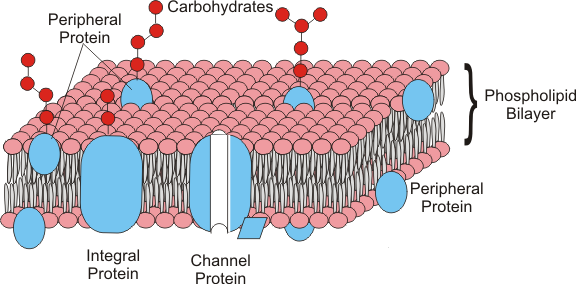
Assertion: Peripheral proteins are partially or totally buried in the membrane.
Reason: Integral proteins lie on the surface of membrane
(A) Both Assertion and reason are correct and Reason is the correct explanation for Assertion.
(B) Both Assertion and reason are correct but Reason is not the correct explanation for Assertion
(C) Assertion is correct but reason is incorrect
(D) Both Assertion and Reason are incorrect
Answer
563.7k+ views
Hint: Peripheral proteins are defined as the active molecules which are formed from the amino acids. These are the biologically active molecules. These proteins are the membrane proteins that attach temporarily to the membrane of the molecules that they are associated with.
Complete Answer:
Assertion: Integral proteins lie on the surface of membrane:
These proteins when contact with the biological membranes, they attach to the hydrophobic space within his cell membrane. These attach not to the surface they penetrate deep inside the membrane where the fatty acid of the lipid present. Hence the Assertion is incorrect.

Reason: Peripheral membrane proteins are partially or totally buried in the membrane:
These proteins are biologically active and attach to the hydrophilic areas of the membranes. This sequence of amino acids attracts the phosphate group of the head of the phospholipid. These attach to the surface of the membranes and do not go to the inner part of the membrane. Hence the Reason is incorrect.
Thus, the option (D) is correct.
Note: Phospholipids form the lipids bilayer when they contact with the water. It surfaces divided into the bilayer, where the hydrophobic areas present inside and the hydrophilic areas present outside the surface of the membrane. Hence the peripheral proteins attach to the surface and the integral proteins attach to the inner membrane of the protein.
Complete Answer:
Assertion: Integral proteins lie on the surface of membrane:
These proteins when contact with the biological membranes, they attach to the hydrophobic space within his cell membrane. These attach not to the surface they penetrate deep inside the membrane where the fatty acid of the lipid present. Hence the Assertion is incorrect.

Reason: Peripheral membrane proteins are partially or totally buried in the membrane:
These proteins are biologically active and attach to the hydrophilic areas of the membranes. This sequence of amino acids attracts the phosphate group of the head of the phospholipid. These attach to the surface of the membranes and do not go to the inner part of the membrane. Hence the Reason is incorrect.
Thus, the option (D) is correct.
Note: Phospholipids form the lipids bilayer when they contact with the water. It surfaces divided into the bilayer, where the hydrophobic areas present inside and the hydrophilic areas present outside the surface of the membrane. Hence the peripheral proteins attach to the surface and the integral proteins attach to the inner membrane of the protein.
Recently Updated Pages
Master Class 12 Business Studies: Engaging Questions & Answers for Success

Master Class 12 Economics: Engaging Questions & Answers for Success

Master Class 12 English: Engaging Questions & Answers for Success

Master Class 12 Maths: Engaging Questions & Answers for Success

Master Class 12 Social Science: Engaging Questions & Answers for Success

Master Class 12 Chemistry: Engaging Questions & Answers for Success

Trending doubts
What are the major means of transport Explain each class 12 social science CBSE

Which are the Top 10 Largest Countries of the World?

Draw a labelled sketch of the human eye class 12 physics CBSE

How much time does it take to bleed after eating p class 12 biology CBSE

Explain sex determination in humans with line diag class 12 biology CBSE

Differentiate between homogeneous and heterogeneous class 12 chemistry CBSE




